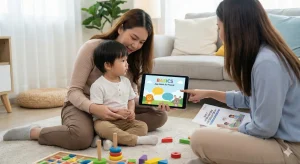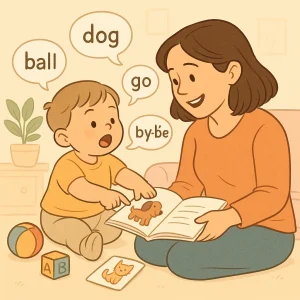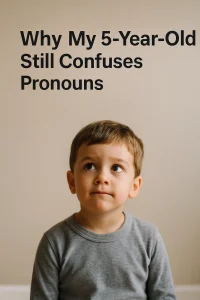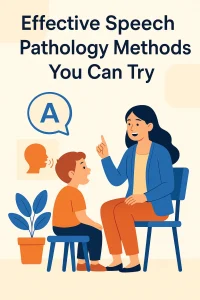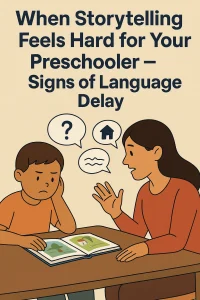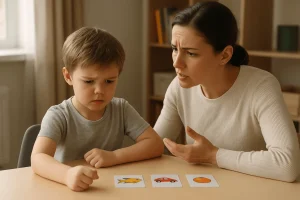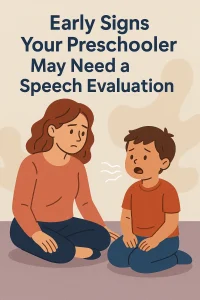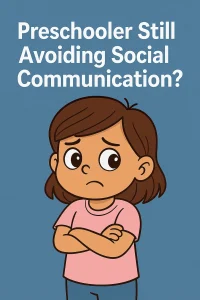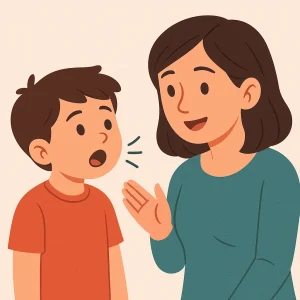What to Do If Your Toddler Struggles With Eye Contact and Speech
Last Updated: September 1, 2025
Is your toddler not talking much—or avoiding eye contact altogether? It’s natural to worry when your little one doesn’t meet typical speech or social milestones, especially between 18–24 months. For many parents, concerns about toddler eye contact and speech delay raise questions like “Is this normal?” or “Could this be a sign of autism?”
Whether your child avoids eye contact, struggles to say their first words, or seems socially distant, you’re not alone—and there’s help. From understanding early signs of communication delays to exploring speech therapy apps or autism apps for toddlers, this guide will walk you through what to look for, when to act, and how to support your child’s speech and social development at home.
Free Speech Help for Kids
Concerned about speech delays? Book a free consultation with our expert speech therapist and get guidance tailored to your child’s needs.
Is It Normal for Toddlers to Avoid Eye Contact or Speak Late?
It’s one of the most common concerns among parents of toddlers: “Why doesn’t my child look at me when I talk?” or “My toddler avoids eye contact and doesn’t talk—should I be worried?” These questions often spark anxiety, especially as your child reaches key developmental stages around 18 to 24 months.
Understanding Developmental Milestones
By 18 months, most toddlers:
- Make eye contact during play and while communicating needs
- Use at least 10–20 words
- Imitate simple gestures or sounds
- Respond to their name and simple directions
By 24 months, many children:
- Combine two words (like “more juice” or “mama come”)
- Show interest in others’ emotions
- Engage in basic pretend play
- Use eye contact more naturally in social settings
So, if your child is not making eye contact or not using words by 2 years old, it doesn’t always mean something is wrong—but it can be an early flag for a developmental delay, including autism spectrum disorder (ASD).
What’s Typical vs When to Be Concerned
All children develop at their own pace, and some kids may simply be shy, independent, or late bloomers. However, certain patterns—like a lack of eye contact combined with minimal speech—deserve closer attention.
“If a toddler consistently avoids eye contact, doesn’t respond to their name, and isn’t saying at least a few words by 18–24 months, it’s important to get an evaluation,” says Anuradha Karanam, our certified speech-language pathologist.
You might notice:
- Your toddler rarely looks at you during interactions
- They don’t point, wave, or use gestures to communicate
- They seem more interested in objects than people
- They don’t copy words or sounds even after exposure
These signs don’t confirm a diagnosis—but they may indicate the need for a developmental screening.
Trust Your Instincts, and Act Early
If you’re wondering whether it’s just a phase or something more, trust your gut. Many parents who noticed that their toddler avoids eye contact and doesn’t talk were the first to advocate for early support—and that makes a big difference.
Early support may include speech therapy, developmental play strategies, or even trying a speech therapy app or autism app for toddlers designed to strengthen eye contact, imitation, and communication skills.
Common Causes Behind Delayed Speech and Poor Eye Contact
When a child isn’t speaking much or avoids looking at others, it’s natural for parents to feel confused or even alarmed. You may start to wonder: Is it just a delay? Or something more serious? Understanding what causes speech delay in toddlers and the reasons behind toddler eye contact issues can help you take the right next steps.
1. Autism Spectrum Disorder (ASD)
One of the most common concerns when a child shows both speech delay and poor eye contact is Autism Spectrum Disorder (ASD). Autism affects the way a child interacts, communicates, and learns from the world. Not all children with speech delays have autism—but if your child also avoids eye contact, doesn’t respond to their name, or shows limited interest in social play, it could be one of the early signs of autism in toddlers.
Children on the spectrum often struggle with back-and-forth communication—this includes eye gaze, facial expressions, gestures, and verbal speech. They may focus on specific interests or routines and find it difficult to engage in typical toddler play.
If you’re noticing multiple signs like:
- Rarely making eye contact
- Limited use of gestures (like pointing or waving)
- Delayed speech with few or no words by age 2
- Repetitive behaviors or strong attachment to routines
…it’s important to seek a professional evaluation. Early intervention can make a life-changing difference.
2. Hearing Issues or Sensory Processing Disorder
Sometimes, speech delay can stem from hearing challenges. If your toddler can’t hear clearly, they may struggle to pick up on sounds, words, or even know that someone is talking to them—resulting in both limited verbal skills and reduced eye contact.
A child with even mild hearing loss may appear to “tune out” or not respond when spoken to—mimicking some of the signs of autism in toddlers.
Additionally, Sensory Processing Disorder (SPD) can affect how children respond to sound, light, and touch. A child who is overwhelmed by sensory input might avoid eye contact or verbal interaction—not out of defiance, but as a coping mechanism.
3. Late Talkers vs. Children With Speech Delays
Not all toddlers who speak late have a disorder. Some are what experts call “late talkers”—children who have a good understanding of language and social interaction but take a little longer to start speaking.
Late talkers usually:
- Use gestures and eye contact well
- Understand what’s said to them
- Catch up with their peers by age 3
In contrast, a child with a true speech or language delay may struggle with both understanding and using words. If your toddler doesn’t seem to understand simple instructions or avoids eye contact even when spoken to, it may be more than just a phase.
When to Take Action
Every child develops differently, but if your toddler shows consistent eye contact issues and limited speech progress past 18–24 months, it’s wise to explore support options. These may include speech therapy, hearing tests, or development-focused tools like a speech therapy app or autism app for toddlers that make learning more engaging and accessible.
5 Early Signs That May Indicate Autism or Communication Delay
As a parent, you know your child best. So when something feels “off”—like your toddler not responding to their name or rarely looking at you—it’s completely valid to wonder what’s going on. While every child develops at their own pace, certain behaviors may point toward communication delays or even be early signs of autism in toddlers.
Understanding these signs doesn’t mean jumping to conclusions—it means being informed and proactive.
Here are 5 signs to look for, especially if your child is around 18–24 months old:
1. Lack of Eye Contact
Consistent eye contact is one of the first ways babies connect with the people around them. By the age of 1, most children make regular eye contact while playing, sharing, or seeking attention. A child on the autism spectrum, however, may avoid or seem indifferent to eye contact.
If your toddler rarely looks at your face during interactions, doesn’t make eye contact when excited or upset, or avoids it altogether—it could be one of the first autism signs in a 2-year-old.
2. No Response to Their Name
By 9–12 months, most babies begin to respond to their names. They might look up, turn their head, or smile when called. But if your toddler consistently ignores their name—especially in quiet environments—it may indicate a communication concern or sensory processing issue.
Not responding can sometimes be mistaken for stubbornness or distraction, but when combined with other behaviors, it becomes more significant.
3. Limited Gestures Like Pointing or Waving
Gestures like pointing, waving “bye-bye,” or nodding are crucial pre-verbal communication tools. A toddler who doesn’t point to show interest, wave to greet others, or shake their head to say “no” may be missing important developmental markers.
These are among the more visible signs of autism in toddlers, especially when the child isn’t substituting gestures with words or other means of expression.
4. Not Using Words by 18–24 Months
While it’s true that all children speak at different ages, most toddlers begin saying their first words around 12 months and combine two words by 24 months. If your child still isn’t using single words or shows very limited vocabulary by age 2, it’s time to explore why.
This could point to:
- Speech delay
- Hearing issues
- Or one of the autism signs in a 2-year-old
The earlier you catch this, the easier it is to get help.
5. Little or No Interest in Social Interaction
Children are naturally curious and social—even shy toddlers usually warm up to familiar people. But if your toddler prefers to play alone all the time, doesn’t watch other kids, or doesn’t seek your attention, this could suggest a deeper social or developmental challenge.
They may not bring toys to show you, avoid imitation games like peek-a-boo, or not seem interested in shared experiences. These are often some of the earliest, but most overlooked, autism signs in toddlers.
Why These Signs Matter
You don’t need to panic if your child shows just one of these behaviors occasionally. But when multiple signs are present and persistent, it’s worth scheduling a developmental screening or talking to a pediatrician.
Early intervention—whether through professional therapy, parent-led strategies, or tools like a speech therapy app or autism app for toddlers—can make a remarkable difference in your child’s ability to connect, communicate, and thrive.
When to Seek Help for Speech and Eye Contact Concerns
It’s easy to fall into the trap of thinking, “They’ll talk when they’re ready,” or “Maybe my child is just shy.” While many children do follow their own timelines, there are moments when a delay in speech or lack of eye contact could signal something more. So when should you worry about your child not talking, or not making eye contact?
The answer lies in knowing what’s typical—and what’s not.
Red Flags That Deserve Attention
If your child is between 18 to 24 months and shows one or more of the following, it’s a good idea to seek a professional opinion:
- Doesn’t say even a few clear words by 18 months
- Rarely or never makes eye contact, even with familiar people
- Doesn’t respond to their name being called
- Doesn’t point, wave, or use simple gestures to communicate
- Shows little interest in playing with others
- Avoids looking at faces, even during play or comforting moments
These signs may not mean your child has a disorder—but they are important communication and social markers. Ignoring them or waiting too long can delay access to early support that makes a real difference.
Who Should You Talk To?
The first step is to trust your gut. If you feel something is off, you’re probably right.
Start by discussing your concerns with your:
- Pediatrician – They can screen for basic developmental milestones and refer you to a specialist if needed.
- Speech-Language Pathologist (SLP) – A certified SLP can assess your child’s communication skills, including speech clarity, understanding, and social interaction.
- Child Psychologist or Developmental Pediatrician – If autism or a broader developmental issue is suspected, they can provide detailed evaluations and guide a formal diagnosis.
You don’t need to wait for a doctor to tell you there’s a problem. Parents are often the first to notice that something isn’t right.
Why Early Diagnosis and Therapy Matter
The brain develops rapidly in the early years. That means the earlier you intervene, the better the chances of improving communication, social skills, and learning.
Whether the concern is speech delay, autism, or something else entirely, early support leads to better outcomes. And help doesn’t always mean formal clinic visits—many families today also use tools like a speech therapy app or an autism app for toddlers to begin supporting their child’s development from home.
These digital tools are especially helpful for:
- Practicing first words
- Improving joint attention and eye contact
- Encouraging back-and-forth interactions
- Tracking developmental progress
Final Thought
If you’re wondering, “When should I worry about my child not talking?”—the best time to act is now. An evaluation doesn’t hurt, and even if everything turns out fine, you’ll gain peace of mind and confidence in your parenting.
Remember, early action is not overreacting. It’s being proactive about your child’s future.
Best Ways to Help Your Toddler at Home
If your toddler is showing signs of a speech delay or struggles with social connection, you might be wondering what you can do before (or alongside) professional therapy. The good news? As a parent, you play a powerful role in supporting your child’s development—right from the comfort of your home.
Whether your child has been formally evaluated or you’re still in the observation phase, here are some simple, effective strategies for how to help a 2-year-old with speech delay and build better connection day by day.
1. Engage in Play-Based Speech Activities
Young children learn best through play. Everyday moments—like stacking blocks, feeding a doll, or pretending to cook—are rich opportunities for language growth. While playing:
- Narrate what you’re doing: “Let’s pour the juice! Pour… pour…”
- Repeat simple words often: “Ball! Throw the ball!”
- Use fun sounds and exaggerated expressions to keep their attention
For toddlers with limited words, focus on functional language (like “more,” “go,” or “help”) instead of just naming objects.
2. Try Imitation and Turn-Taking Games
Even before using words, your child needs to learn how to take turns in conversation. That starts with simple back-and-forth actions, like:
- Rolling a ball to each other
- Making animal sounds and waiting for them to copy
- Blinking, clapping, or tapping and pausing for imitation
These games are fun, pressure-free, and build the foundation for communication.
If your child is nonverbal or mostly silent, don’t worry about speech at first. Focus on shared moments, facial expressions, and joyful interaction—that’s where language begins.
3. Use Visual Cues, Gestures, and Predictable Routines
Children with delayed speech or social understanding often benefit from visual support. Use hand gestures, picture cards, or daily routine boards to show your child what’s happening and what you expect.
For example:
- Point to your mouth while saying a word
- Use the “more” or “all done” sign during meals
- Sing simple songs with consistent actions
These strategies help reinforce understanding and reduce frustration for children who struggle to express themselves.
4. Limit Screen Time — and Make It Interactive
While videos and cartoons may hold your child’s attention, passive screen time doesn’t support speech development the way interactive play does. If you do use screens, choose apps or activities that invite active participation, like naming, touching, or copying sounds.
One helpful option is using a therapy app for nonverbal toddlers, which is specifically designed to:
- Encourage speech through repetition and visuals
- Offer structured turn-taking games
- Reinforce gestures, eye contact, and simple requests
- Track progress and adapt to your child’s level
Every Small Effort Counts
You don’t need to be a speech therapist to make a difference. By simply being present, playful, and consistent, you’re giving your child the best chance to grow.
Still unsure how to help a 2-year-old with speech delay? Start small. Pick one routine—like snack time or bath time—and turn it into a mini speech session. Repeat, pause, wait, and celebrate every little sound or look they give you. That’s how progress begins.
Also read: How to Create a Screen Time Schedule That Actually Works
Try These Speech Therapy and Autism App for Toddlers
When your toddler is struggling with speech or social communication, the right tools can make all the difference. Using a speech therapy app or an autism app for toddlers is a great way to support their development in a fun and accessible way—right from home.
BASICS App – India’s Leading Speech Delay App for Toddlers
The BASICS App is a trusted solution for parents looking for structured, expert-backed support for their toddler’s speech delay. Developed by certified speech-language pathologists, this app offers:
- Play-based activities tailored for toddlers
- Speech and language exercises focused on first words, imitation, and interaction
- Visual prompts and repetition for children with minimal or no speech
- Daily progress tracking for parents and therapists
Whether your child is showing signs of autism or simply needs help starting to speak, BASICS is built to engage young minds and support their communication journey.
How a Speech Delay App Can Support Daily Practice
For parents navigating speech delays in young children, consistency is key. But between busy schedules and limited access to therapy, maintaining daily practice can be a challenge. That’s where a speech delay app for kids becomes an incredibly helpful tool.
Designed specifically for toddlers and preschoolers, these apps turn learning into play—making speech practice feel less like work and more like fun.
Apps Reinforce What’s Learned in Therapy
When used alongside professional support, a toddler communication app can help reinforce strategies taught during speech therapy sessions. These apps often follow the same techniques used by certified speech-language pathologists (SLPs), such as:
- Repetition of key sounds and words
- Modeling gestures and expressions
- Visual and audio prompts to guide interaction
- Simple language-building routines children can follow daily
By practicing these skills more frequently at home, children are more likely to retain what they learn and apply it in real-life settings.
Gamified Learning Keeps Toddlers Engaged
Let’s face it—toddlers learn best when they’re having fun. Most speech apps for kids include game-like features such as:
- Animated characters
- Reward systems (like stars or badges)
- Interactive buttons and sound effects
- Matching, tapping, and naming games
This gamified approach keeps children motivated to participate and helps reduce resistance, especially for those who are shy or easily distracted.
Simple Language-Building Activities You’ll Often Find in Apps:
- First Word Repetition: The child hears and repeats simple words like “mama,” “ball,” or “up”
- Sound Imitation: Fun animal sounds or environmental sounds that encourage vocal play
- Picture Naming: Tap a picture of an object and say its name out loud
- Gesture & Sign Modeling: Reinforce meaning with actions like waving or pointing
- Yes/No and Choice Questions: Build understanding through simple decision-making tasks
These small, structured activities only take a few minutes but have a big impact when practiced regularly.
The Benefit for Parents
Using a speech delay app for kids empowers parents to become active participants in their child’s learning. It removes the guesswork and provides guided sessions that feel purposeful, not overwhelming.
Whether your child is nonverbal or just learning to put words together, a high-quality toddler communication app supports steady progress—one word, one gesture, one joyful connection at a time.
Conclusion
If your toddler avoids eye contact or isn’t talking yet, don’t wait for things to improve on their own. Early steps make a big difference! As a parent, your love, time, and daily support matter the most. Use simple tools like the BASICS speech therapy app, speech delay checklists, or talk to a speech expert. Helping your child doesn’t have to be hard—you can start at home, today. Every small effort counts. Stay hopeful, take action early, and remember—you’re not alone in this journey. Your child can grow, learn, and thrive with your support.
Frequently Asked Questions:
1. Is it normal if my 2-year-old doesn’t make eye contact?
Many toddlers avoid eye contact at times, especially when they’re tired, distracted, or overwhelmed. But if your 2-year-old often avoids looking at you during play, doesn’t look when you speak to them, or rarely shares eye contact even in fun moments, it could be more than a phase. Poor eye contact can be one of the early signs of autism or a social communication delay. It’s a good idea to speak with your pediatrician or a child development specialist if you’re noticing this consistently.
2. When should I worry if my toddler is not talking yet?
Every child develops at their own pace, but most toddlers start saying single words like “mama” or “ball” by 12 to 15 months and combine words like “want milk” by age 2. If your child isn’t saying any clear words by 18 months or doesn’t try to put words together by 2 years, it may be time to seek help. The earlier you start, the better the chances of improving their speech and language skills.
3. Why does my toddler avoid eye contact and not talk?
If your toddler avoids eye contact and isn’t talking, it could be due to several reasons. They might have a speech delay, hearing problem, or be showing early signs of autism. In some cases, it might just be part of their personality or natural shyness. But when both speech and social behaviors are delayed, it’s worth getting an evaluation from a pediatrician or speech-language pathologist. Early support can make a big difference in your child’s development.
4. What causes speech delay in toddlers?
Speech delays can happen for many reasons. Some children may have difficulty hearing, which makes it harder for them to learn words. Others may have developmental delays, autism spectrum disorder, or trouble understanding how to use language. In some cases, toddlers are simply late talkers and catch up on their own. A speech-language pathologist can help you figure out why your child isn’t talking yet and what steps to take next.
5. Can a speech therapy app help my toddler talk?
Yes! A speech therapy app for kids, like the BASICS app, can be a great tool to support your child’s communication development at home. These apps use fun games, visual prompts, and sound repetition to help toddlers learn words, improve eye contact, and practice turn-taking. They are designed by experts and are especially helpful for nonverbal toddlers or those with speech delays. While they don’t replace therapy, they’re a great way to practice every day.
6. What are early signs of autism in a 2-year-old?
Some common signs of autism in toddlers include:
- Limited or no eye contact
- Not pointing or waving
- Not responding to their name
- Preferring to play alone
- Using few or no words
- Repeating actions (like spinning objects or flapping hands)
Every child is different, but if you notice several of these behaviors happening often, it’s a good idea to speak with a developmental pediatrician. Early screening helps provide support if needed.
7. How can I help my child talk more at home?
You can do a lot at home to support your child’s speech development. Talk to your toddler during daily routines like bath time, meals, and play. Use simple, clear words and repeat them often. Encourage your child to imitate sounds and gestures. Play games that involve turn-taking and naming objects. You can also try using a toddler communication app to make learning fun and interactive. Even a few minutes of daily practice can help your child make progress.
8. Who should I talk to if I’m worried about my toddler’s speech?
If you’re concerned about your child’s speech or eye contact, start by talking to your pediatrician. They’ll check your child’s development and may refer you to a speech-language pathologist (SLP) for a detailed speech evaluation. In some cases, your doctor might also recommend a developmental pediatrician or child psychologist to check for signs of autism or other delays. Don’t wait—early action can lead to better outcomes.
9. What is the difference between a late talker and a speech delay?
A late talker is a child who speaks later than expected but still understands language well, uses gestures, and interacts socially. These children often catch up by the age of 3 without needing much help. A child with a speech delay, on the other hand, may struggle with both understanding and using language. They might not follow simple directions, use gestures, or show interest in communication. A speech therapist can help tell the difference and guide the next steps.
10. Is there a good autism app for toddlers?
Yes! The BASICS app is a top-rated autism and speech therapy app designed specifically for toddlers. Created by experts, it supports children with speech delays or signs of autism through structured, engaging activities that focus on communication, attention, and daily routines.
About the Author:
Anuradha Karanam
Speech-language pathologist (7+ years of experience)
Anuradha Karanam is a skilled speech-language pathologist with over 6 years of experience. Fluent in Tamil, Telugu, Hindi, and English, she specializes in parent counseling, speech sound disorders, fluency assessment, and speech-language evaluations. Anuradha excels at working with children with developmental disorders, offering creative and effective therapy programs. Currently, at Wellness Hub, she holds a BASLP degree and is registered with the RCI (CRR No A85500). Her patience, ambition, and dedication make her a trusted expert in her field.
Book your Free Consultation Today
Parent/Caregiver Info:
Client’s Details:
* Error Message
